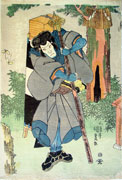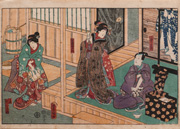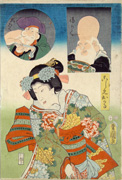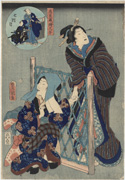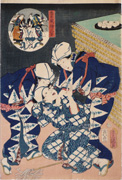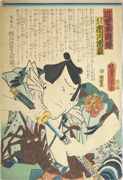Prints in Collection
The actors Iwai Shijaku, Ichikawa Komazō V and Matsumoto Kōshirō V in Date Kurabe Okuni Kabuki, 1836
IHL Cat. #953
no hanamuko an interact in the play Kanadehon Chūshingura, 1857
IHL Cat. #515
Viewing Fireflies in the Cool of the Evening, 1859
IHL Cat. #955
Actor Ichikawa Ichizō III as Nadare no Wakamatsu from the series A Modern Shuihuzhuan, 1862
IHL Cat. #645
Biographical Data
Profile
Utagawa Kunisada I 歌川国貞 (1786-1865)Source: The Hotei Encyclopedia of Japanese Woodblock Prints, Amy Reigle Newland, Hotei Publishing Company, 2005, p.502-503; The Japanese Print: A Historical Guide, Hugo Munsterberg, Weatherhill, 1982, p.128-131; The Art of Japanese Prints, Richard Illing, John Calmann & Cooper Ltd., 1980, p. 56-57.
Kunisada was the most prolific and commercially-successful of all woodblock print designers. Although he designed many bijin-ga (prints of beautiful women), kabuki actors were his main specialty and formed about 60% to 70% of his output of over twenty-thousand prints.
Kunisada started his career as a pupil of Utagawa Toyokuni I (1769-1825) whose name he adopted in 1844, becoming Toyokuni III (三代歌川豊国). While he changed his names several times, he is commonly referred to as Kunisada or Toyokuni III. Kunisada was not only a brilliant print maker but also an excellent businessman who had great commercial success.
Biography
Kunisada grew up in the Hongo district of Edo (Tokyo), the son of a well-to-do ferry owner. His given name was Sumida Shōgorō IX (角田庄五朗), and he was also called Sumida Shōzō (角田庄蔵).1 His father, an amateur poet of some renown, died in the year after his birth.2 In 1801, at the age of fifteen he became a pupil of Toyokuni and was given the artist name Kunisada soon thereafter. In 1807 he produced his first independent work as a book illustrator, and in 1808 his first actor print was published. In 1809 he was referred to in contemporary sources as the “starattraction” of the Utagawa school, and soon thereafter was consideredas at least equal to his teacher Toyokuni in the area of bookillustration.3 In about 1813 he began signing his work Gototei Kunisada. (Gototei meaning Fifth Ferry House.) From the 1820s he ran a large studio which dominated print production into the beginning of the Meiji era.4 In 1827 he adopted an additional go (artist name), occasionally signing Kōchōrō Kunisada (mainly on non-actor prints) until, in 1844, he took the name Toyokuni III.5 Other listed names for the artist include Utagawa (Tsunoda), Fubō-sanjin, Fu-chōan,Gepparō, Hokubaiko, Ichiyūsai, Kinraisha, and Tōjuen.6Kunisada was one of the primary illustrators of popular fictionand developed close ties with prominent literary figures. His firstfamous series of prints (1828-42) illustrated a whimsical adaptation ofthe famous 11th-century Genji Monogatori (Tales of Genji) by Murasaki Shikibu, a text hecontinued to illustrate throughout his career.7
In addition to actor prints (yakusha-e) and book illustrations (kuchi-e), he produced erotic prints (shunga), pictures of beautiful women (bijin-ga), landscapes and privately commissioned prints (surimono.) He died at the age of seventy-eight on January 12, 1865 and worked in Hongo up until his death. His posthumous Buddhist name is Hōkokuin Teishōgasen Shinji and he was buried at the Banshōin Kōunji1, like Toyokuni and Kunisada II after him.8
1 Banshoin Kounji Temple in Kami-Takada (in present-day Tokyo's Nakano Ward).
Critical Acceptance
While Kunisada was one of the most commercially successful ukiyo-e artists and while his work was much admired by his contemporaries, he was not considered a significant artist by Western critics and his works were often called "inferior" and "decadent". It was not until theearly 1990’s, with the appearance of Jan van Doesburg’s overview of theartistic development of Kunisada, and Sebastian Izzard’s extensivestudy of his work, that this picture began to change, with Kunisadamore clearly revealed as one of the “giants” of the Japanese print.9Pupils
Numerous artists worked in his studio and studied with him including Utagawa Sadahide (1807-1873), Utagawa Fusatane (active 1854-1888), Utagawa Kunisada II (1823-1880), Utagawa Kuniteru II (1830-1874), Utagawa Kokunimasa (1874-1944) and Toyohara Kunichika (1835–1900).1 Wikipedia website http://en.wikipedia.org/wiki/Kunisada
2 Ibid.
3 Ibid.
4 The Hotei Encyclopedia of Japanese Woodblock Prints, Amy Reigle Newland, Hotei Publishing Company, 2005, p. 502.
5 The name Toyokuni II had already been taken by Toyoshige (1777-1835), the son-in-law of Toyokuni. In 1844 Kunisada signed several of his prints "Kunisada changing to the second Toyokuni," totally ignoring Toyoshige's claim to the name.
6 A Dictionary of Japanese Artists: Painting, Sculpture, Ceramics, Prints, Lacquer, Laurance P. Roberts, Weatherhill, 1976, p. 96-97.
7 Website of the Crocker Art Museum http://www.crockerartmuseum.org/exhibitions/exhib_pages/Kunisada.htm
8 Japanese Woodblock Prints: Artists, Publishers and Masterworks 1680-1900, Andreas Marks, Tuttle Publishing, 2010, p. 120.
9 op cit. Wikipedia
Signatures and Seals
For the most comprehensive presentation of Kunisada's signatures and seals go to http://www.kunisada.de/Liste/kunisada-signature-seal.html
Links to Kunisada Websites
http://www.kunisada.de/ The "Utagawa Kunisada (Toyokuni III) - Project" by Horst Graebner provides an overview of Kunisada's work with thousands of pictures, series titles,lists of actors and kabuki dramas portrayed by Kunisada, and detailedstudy of his artistic names and signatures.http://www.japansociety.org/kabuki_at_the_time_of_kunisada Japan Society article Kabuki at the Time of Kunisada, J. Thomas Rimer.
